Content for TS 23.259 Word version: 18.0.0
5 Procedures and information flows for PN configuration
5.1 PN-registration
5.1.1 General
5.1.2 PN-registration procedure in the IM CN subsystem
5.1.3 PN-registration procedure in the CS domain
5.1.4 PN-registration procedure for PNE other than a PN UE
5.2 PN-deregistration
5.2.1 General
5.2.2 PN-deregistration procedure in the IM CN subsystem
5.2.3 PN-deregistration procedure in the CS domain
5.2.4 PN-deregistration procedure for PNE other than a PN UE
...
...
5 Procedures and information flows for PN configuration p. 9
5.1 PN-registration p. 9
5.1.1 General p. 9
The PN-registration is a procedure where the PN-user requests authorization to use PNM applications. As a result of a successful registration, the UE capabilities can be conveyed to the PNM AS.
5.1.2 PN-registration procedure in the IM CN subsystem p. 9
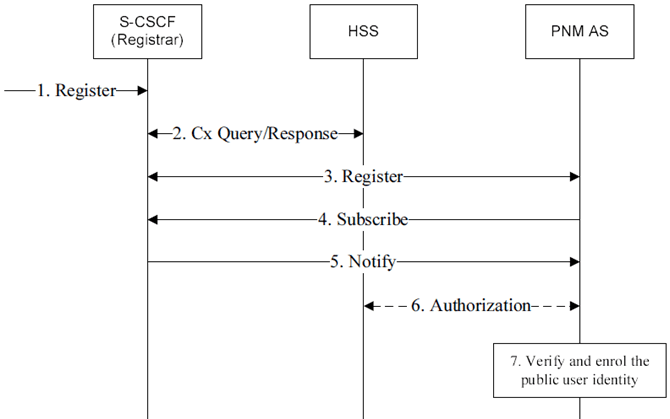
Step 1.
The Register information flow sent by a UE arrives at the S-CSCF/Registrar. The Register information flow contains the private user identity and the public user identity of the UE.
Step 2.
The S-CSCF sends a Cx-Put/Cx-Pull containing the private user identity and public user identity to the HSS and the HSS returns the information flow (eg. the initial filter criteria) to the S-CSCF.
Step 3.
Based on the initial filter criteria, the S CSCF sends a Register information flow to the PNM AS. If the PNM AS specific data, for instance the PN UE name or the private user identity, which is associated with the initial filter criteria, is received from the HSS in Step 2, it is delivered to the PNM AS in the Register information flow.
Step 4.
The PNM AS sends a Subscribe information flow to obtain the public user identity received in the Register information flow in Step 3.
Step 5.
The S-CSCF sends a Notify information flow to the PNM AS containing the public user identities and the UE capabilities. If the S-CSCF assigned a GRUU for the UE during the registration, then the GRUU of the UE is delivered in the Notify information flow.
Step 6.
Optionally, the PNM AS authorizes the PN-registration by querying the HSS. It is done by sending the private user identity to the HSS. The HSS checks the public user identity/identities tied to the private user identity and sends the public user identity/identities and the private user identity back to the PNM AS.
Step 7.
The PNM AS then verifies the PN-registration by comparing the public user identity/identities and the PN UE name or with the other received from S-CSCF in the Step 3. As a result of a successful verification, the PNM AS enrols the public user identity and the PN UE name or as registered in the data base.
5.1.3 PN-registration procedure in the CS domain p. 10
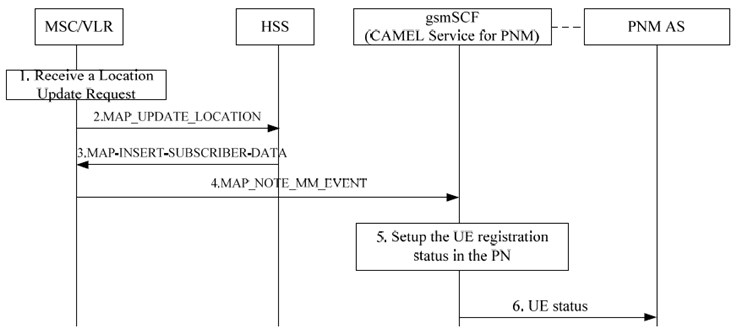
Step 1.
The VLR receives a location update request from a UE.
Step 2.
The VLR sends the MAP_UPDATE_LOCATION message to the HSS to request the subscription information of the UE.
Step 3.
The HSS sends the MAP_INSERT_SUBSCRIBER_DATA message back to update the VLR with the PNM subscriber data.
Step 4.
The VLR changes the status of the UE to 'attached'and sends the MAP_NOTE_MM_EVENT message to the gsmSCF (CAMEL service for PNM) to report the mobile event.
Step 5.
The gsmSCF setups the UE registration status in the PN to 'registered'.
Step 6.
The gsmSCF will send the UE status to the PNM AS.
5.1.4 PN-registration procedure for PNE other than a PN UE |R9| p. 11
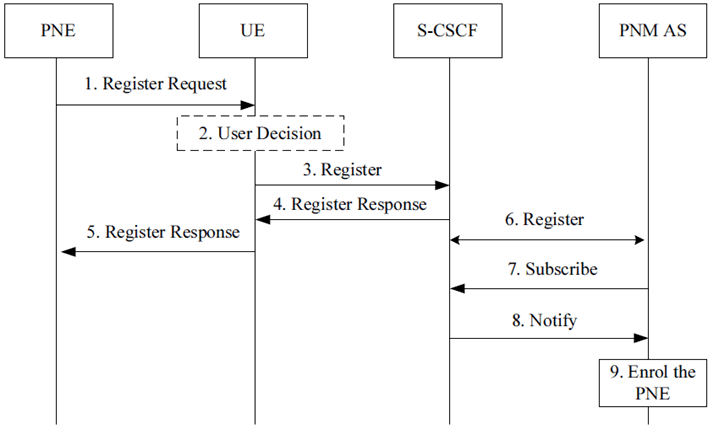
Step 1.
The PNE sends a register request to the UE including its capabilities via the PAN internal communication means.
Step 2.
Optionally, based on the user decision, the PNE is allowed to be added to the PAN.
Step 3.
The UE sends a SIP register request on behalf of the PNE to the S-CSCF. The Register information flow contains the private user identity and the public user identity of the UE, the PNE identifier, and the PNE capabilities.
Step 4.
The S-CSCF sends the register response back to the UE.
Step 5.
UE forwards the register response to the PNE via the PAN internal communication means.
Step 6.
Based on the initial filter criteria, the S CSCF sends a third party Register information flow to the PNM AS.
Step 7.
The PNM AS sends a Subscribe information flow to obtain the public user identities, PNE identifier and the PNE capabilities.
Step 8.
The S-CSCF sends a Notify information flow to the PNM AS containing the public user identities, PNE identifier and PNE capabilities.
Step 9.
The PNM AS enrols the PNE identifier into the PAN.
5.2 PN-deregistration p. 11
5.2.1 General p. 11
Information shall be offered to the user by sending the status if the de-registered UE is the only default UE of the PN.
Figure 5.2.2-1 provides the procedure in the IM CN subsystem to inform the PN-user about De-registration of the only default UE in the PN.
Figure 5.2.3-1 provides the procedure in the CS domain to inform the PN-user about De-registration of the only default UE in the PN.
Figure 5.2.4-1 provides the procedure to inform the UE about De-registration of the PNE.
5.2.2 PN-deregistration procedure in the IM CN subsystem p. 12
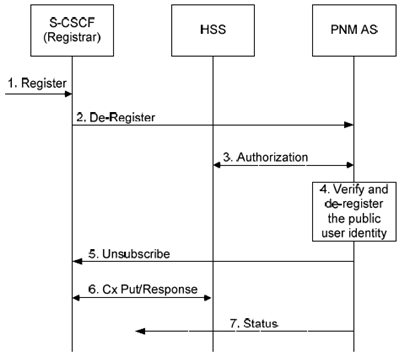
Step 1.
To de-register, the UE sends a new Register information flow with an expiration value of zero seconds. The Register information flow contains the private user identity and the public user identity of the UE.
Step 2.
Based on the initial filter criteria, the S CSCF sends Register information flow with an expiration value of zero seconds to the PNM AS.
Step 3.
Optionally, the PNM AS authorizes the PN-registration by querying the HSS. It is done by sending the private user identity to the HSS. The HSS checks the public user identity/identities tied to the private user identity and sends it back to the PNM AS.
Step 4.
The PNM AS then verifies the PN-registration by comparing the public user identity/identities with the other received from S-CSCF in the Step 2. As a result of a successful verification, the PNM AS enrols the public user identity as de-registered in the data base and removes the stored configuration setting related to this specific public user identity.
Step 5.
The PNM AS sends an Unsubscribe information flow to unsubscribe to the service subscription notification of the public user identity.
Step 6.
The S-CSCF sends a Cx-Put/Cx-Pull containing the private user identity, public user identity and clear/keep S-CSCF name to the HSS base on operator choice and the HSS returns response to the S-CSCF.
Step 7.
If the UE ties to this specific public user identity registered as the only default UE, then the PNM AS sends the status to these UEs of the PN to inform this change.
5.2.3 PN-deregistration procedure in the CS domain p. 12
The PN-deregistration in the CS domain relies on the notification procedure of mobility management event and is accomplished by a notification with the event type of IMSI detach.
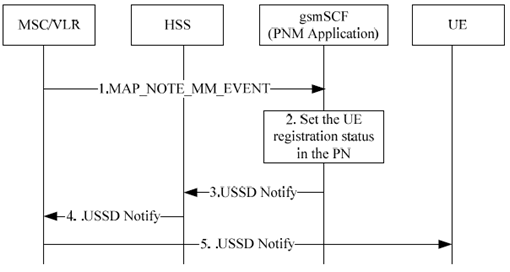
Step 1.
After IMSI detach procedure, the VLR sends the MAP_NOTE_MM_EVENT message to the gsmSCF (CAMEL service for PNM) to report the mobile event.
Step 2.
The gsmSCF sets up the PN UE registration status in the PN to 'Deregistered'.
Step 3.
The gsmSCF checks whether the PN UE was the only default UE in the PN or not. If it was the only default UE in the PN, the gsmSCF generates the USSD Notify message to the HSS.
Step 4-5.
The HSS forwards this message to the PN UE via MSC/VLR according to TS 23.090.
5.2.4 PN-deregistration procedure for PNE other than a PN UE |R9| p. 14
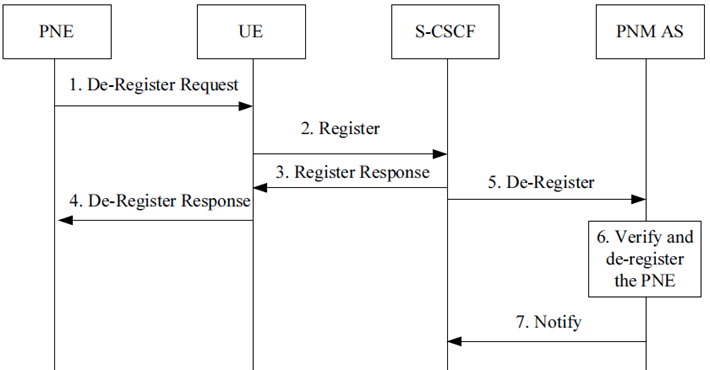
Step 1.
The PNE sends a de-register request to the UE via the PAN internal communication means.
Step 2.
The UE sends a register request on behalf of the PNE to the S-CSCF with an expiration value of zero seconds.
Step 3.
The S-CSCF sends the register response back to the UE.
Step 4.
The UE sends the de-register response to the PNE via the PAN internal communication means.
Step 5.
Based on the initial filter criteria, the S CSCF sends a De-Register information flow to the PNM AS.
Step 6.
The PNM AS then verifies the PN-deregistration by comparing the PNE identifier with the other received from S-CSCF. As a result of a successful verification, the PNM AS enrols the PNE identifier as de-registered in the data base and removes the stored configuration setting related to this specific PNE identifier.
Step 7.
The PNM AS sends a Notify information flow to the S-CSCF containing the register status of PNE.